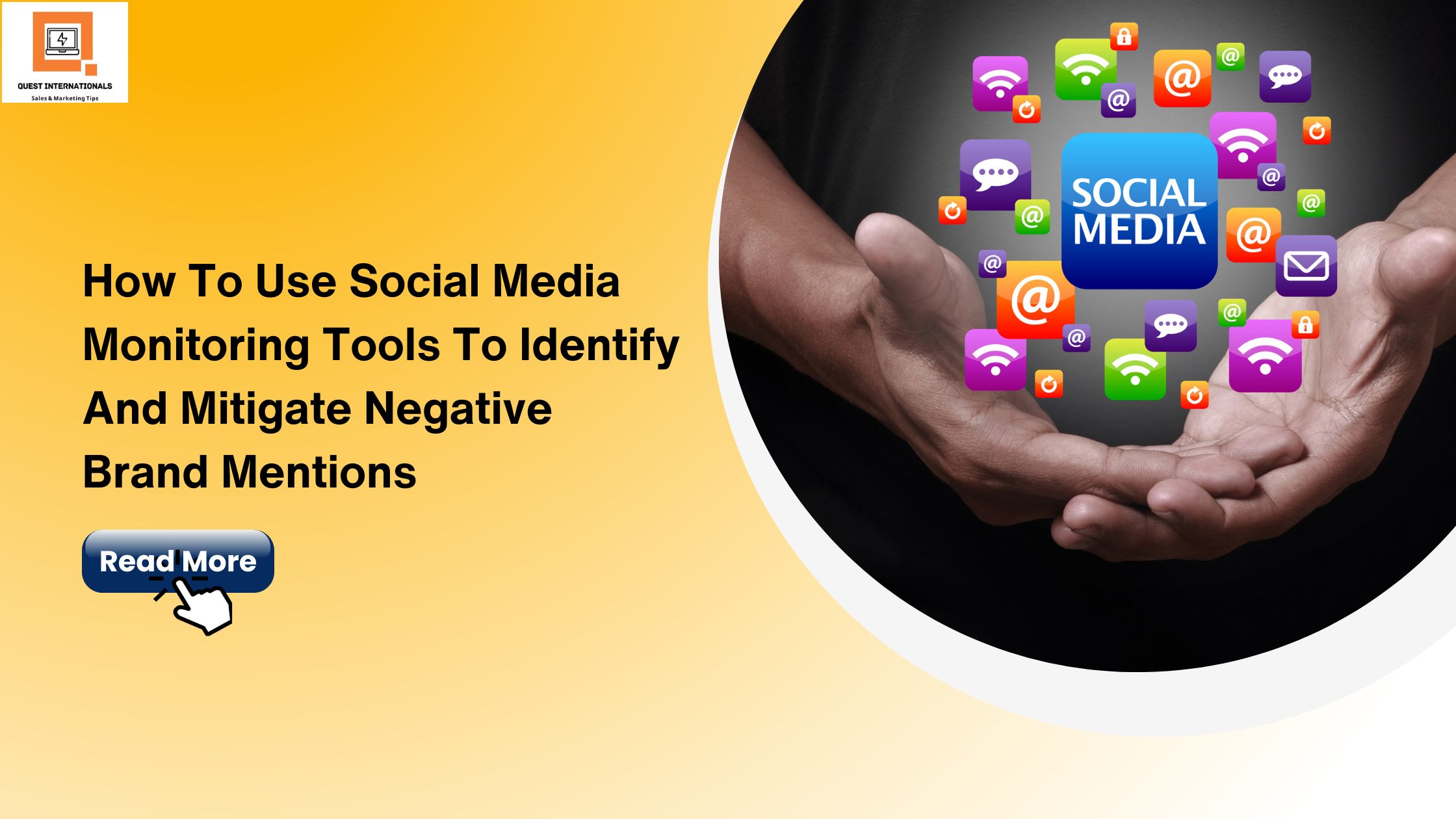Social media monitoring tools are crucial for businesses that want to have a strong online presence and reputation. With millions of users on social media platforms, it can be challenging to keep track of what people are saying about your brand. How to use social media monitoring tools can be overwhelming, but they allow businesses to track mentions of their brand, products, and services across different social media platforms, blogs, forums, and news sites.
Negative brand mentions can be detrimental to a company’s reputation and bottom line. Additionally, such mentions can originate from various sources such as dissatisfied customers, competitors, or even employees. These mentions may take the form of negative reviews, complaints, or critical comments. It’s important to note that negative mentions can spread rapidly on social media, and if not adequately addressed, they can cause irreparable harm to a company’s reputation.
Therefore, it is crucial for businesses to use social media monitoring tools to identify and mitigate negative brand mentions. In this blog, we will discuss how businesses can use social media monitoring tools to identify and mitigate negative brand mentions and the importance of doing so.
What are social media monitoring tools?

Social media monitoring tools are software applications that allow businesses to track and monitor their brand’s online presence on social media platforms, blogs, forums, news sites, and other websites. Additionally, these tools use advanced algorithms to crawl the web and track specific keywords, phrases, and hashtags related to a brand, product, or service. As a result, social media monitoring tools provide businesses with valuable insights into their customers’ online behavior. With this information, businesses can create more effective social media marketing strategies, engage with customers more effectively, and address negative brand mentions quickly. Moreover, by identifying trends, sentiments, and influencers related to their brand, businesses can stay ahead of the curve and proactively adjust their marketing strategies to align with their customers’ needs and preferences.
Some of the popular social media monitoring tools are:
- Hootsuite – This tool is popular among businesses of all sizes, and it allows users to manage multiple social media accounts from a single platform. Hootsuite also offers advanced monitoring and reporting features that allow businesses to track their brand’s online presence effectively.
- Mention – This tool allows businesses to monitor their brand’s online presence across multiple platforms, including social media, blogs, forums, and as well as news sites. Mention offers advanced analytics and reporting features that allow businesses to track sentiment, engagement, and reach.
- Brandwatch – This tool is ideal for businesses that require advanced social media monitoring features, such as sentiment analysis, influencer identification, and crisis management. Brandwatch offers real-time monitoring and reporting features that allow businesses to track their brand’s online presence effectively.
Overall, social media monitoring tools are essential for businesses that want to manage their brand’s online reputation effectively and engage with customers on social media platforms.
Why social media monitoring is important for businesses
Social media monitoring is essential for businesses for several reasons. Here are some of the benefits of social media monitoring:
1. Reputation management – Social media monitoring tools allow businesses to track their brand’s online presence and reputation. By monitoring social media platforms, blogs, and news sites, businesses can quickly identify negative brand mentions and address them before they escalate.
2. Customer engagement – Social media monitoring allows businesses to engage with customers in real time. By responding to customer inquiries, comments, and feedback, businesses can improve customer satisfaction, build brand loyalty, and attract new customers.
3. Competitor analysis – Social media monitoring tools allow businesses to monitor their competitors’ online presence and strategies. By tracking their competitors’ social media metrics, businesses can identify trends, opportunities, and potential threats.
4. Crisis management – Social media monitoring tools allow businesses to identify and respond to potential crises quickly. By monitoring social media platforms, businesses can identify negative brand mentions and take appropriate action to address the situation before it escalates.
Several companies have benefited from social media monitoring, including:
- Southwest Airlines – Southwest Airlines uses social media monitoring tools to track customer feedback and complaints. By responding to customer inquiries and complaints promptly, Southwest Airlines has improved customer satisfaction and loyalty.
- Coca-Cola – Coca-Cola uses social media monitoring tools to track its brand’s online presence and engagement. By monitoring social media platforms, Coca-Cola has been able to identify and respond to customer inquiries and feedback effectively.
In summary, social media monitoring is essential for businesses that want to manage their brand’s online reputation, engage with customers effectively, and stay competitive in their industry.
How to use social media monitoring tools to identify negative brand mentions
When negative brand mentions occur, it’s important for businesses to have a response plan in place. Here are some steps businesses can take to respond to negative brand mentions effectively:
- Monitor social media platforms – Use social media monitoring tools to track your brand’s online presence and identify negative brand mentions as soon as they occur.
- Assess the situation – Determine the severity of the negative mention and assess the potential impact on your brand’s reputation.
- Respond promptly – Respond to the negative mention promptly and publicly, acknowledging the customer’s concern and expressing empathy for their experience.
- Offer a solution – Offer a solution to the customer’s issue, either publicly or through direct messaging. Ensure that the solution is appropriate and addresses the customer’s concerns effectively.
- Follow up – Follow up with the customer to ensure that their issue has been resolved satisfactorily and to gather feedback on their experience.
Turning negative brand mentions into positive experiences is also essential for businesses. Here are some tips for turning negative brand mentions into positive experiences:
- Listen and empathize – Listen to the customer’s concerns and express empathy for their experience. Acknowledge their frustration and demonstrate that you value their feedback.
- Take action – Take action to address the customer’s issue and ensure that it does not happen again in the future.
- Apologize – Apologize for the customer’s negative experience and take responsibility for any mistakes that may have occurred.
- Offer a solution – Offer a solution to the customer’s issue that meets their needs and demonstrates your commitment to their satisfaction.
- Follow up – Follow up with the customer to ensure that their issue has been resolved satisfactorily and to gather feedback on their experience.
How to respond to negative brand mentions
When negative brand mentions occur, it’s important for businesses to have a response plan in place. Here are some steps businesses can take to respond to negative brand mentions effectively:
- Monitor social media platforms – Use social media monitoring tools to track your brand’s online presence and identify negative brand mentions as soon as they occur.
- Assess the situation – Determine the severity of the negative mention and assess the potential impact on your brand’s reputation.
- Respond promptly – Respond to the negative mention promptly and publicly, acknowledging the customer’s concern and expressing empathy for their experience.
- Offer a solution – Offer a solution to the customer’s issue, either publicly or through direct messaging. Ensure that the solution is appropriate and addresses the customer’s concerns effectively.
- Follow up – Follow up with the customer to ensure that their issue has been resolved satisfactorily and to gather feedback on their experience.
Turning negative brand mentions into positive experiences is also essential for businesses.
Conclusion
Social media monitoring tools provide businesses with valuable insights into customer behavior, preferences, and opinions, which can be used to improve products, services, and marketing strategies. By responding to customer feedback, businesses can demonstrate their commitment to customer satisfaction and build stronger customer relationships.
In today’s digital age, social media monitoring is essential for businesses that want to stay competitive in their industry and meet their customers’ expectations. By investing in these tools and developing a response plan for negative brand mentions, businesses can protect their brand’s reputation and ensure that customers have positive experiences with their brand.
In conclusion, businesses that embrace social media monitoring tools and use them effectively are more likely to succeed in today’s competitive marketplace. By staying vigilant and responding to negative brand mentions in a timely and effective manner, businesses can mitigate the impact of negative experiences on their brand’s reputation and build stronger relationships with their customers.




